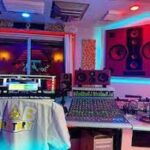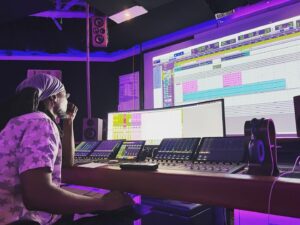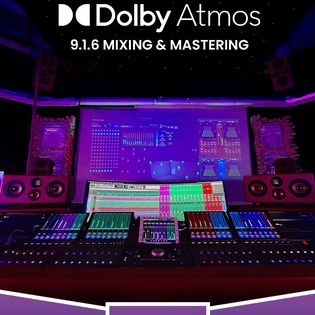When it comes to producing high-quality, mesmerizing music albums, or audio for other entertainment purposes. We can’t miss the most contributing innovation of today- Dolby Atmos.The introduction of Dolby Atmos has changed the whole scenario of how we hear music and soundtracks.
If I have to summarize how Dolby Atmos works and how the sound is generated using Dolby Atmos in Dolby Atmos Studio Atlanta sounds in simple words. I would just say- Amazing! The 3D effect it offers is what makes it different, and premium.
However, incorporating Dolby Atmos just won’t make your music bloom. You need to have premium mixing skills to produce premium-quality music and mixing skills.
In this blog, we will discuss the different ways you can sharpen your Dolby Atmos mixing skills. Doesn’t matter whether you are a beginner in the field, this guide will help you out!
Understanding Dolby Atmos:
Dolby Atmos is the new generation of music technology that is giving new heights to audio format. Thus, allowing you to experience rich, and immersive listening.
Dolby Atmos adds new channels to your music, which in turn allows your soundtracks to move freely in the three-dimensional space. Hence, allowing the music/audio composers to move the sound effects around the listener’s ears.
Dolby Atmos is everywhere! Whether it is filmmaking, providing cinematic experience, gaming, home entertainment, or mobile devices- you just name it!
Let’s get to know in depth, Why Dolby Atmos matters so much.
1. It provides an immersive sound experience to the listeners. Dolby Atmos uses a 3D landscape in which the sounds move freely- up, above, and down, which takes the listening experience to the next level.
2. You get the chance to be creative with Dolby Atmos. As a sound designer, you get the chance to place, and move the audio elements according to your precision.
3. It gives the music industry standard new heights with every use. It is increasingly adopted in music, film, and gaming industries.
4. It provides your music tracks with a better, more natural, and realistic sound quality.
(Also Read More – Acoustical Design Considerations for Dolby Atmos Studios )
Essential Tools for Dolby Atmos Mixing:

No matter how expert you are without proper and essential tools, you can’t really make a good mix!
1. Hardware requirements:
- You will need to have a powerful, and strong computer. By strong computer I mean a computer that has a high CPU, and RAM. As these things are quite important and are needed for recording, and processing the music in real time.
- Proper Dolby Atmos-enabled speakers and headphones, for monitoring which will make sure that the spatial positioning is accurate.
- An audio interface that can support and monitor multi-channel outputs.
- And lastly, a Dolby Atmos renderer that will provide help in creating, monitoring, and exporting Atmos mixes.
2. Software requirements:
1. When it comes to software requirements for a better output. The first thing you need is a DAW- Digital Audio Workstation that supports Dolby Atmos. For instance:
- Avid Pro Tools
- Apple Logic Pro
- Steinberg Nuendo
- Adobe Audition
2. A Dolby Atmos production suite, that will provide the tools required for mixing and rendering Atmos audio.
3. Dolby Atmos Mastering Suite – Advanced suite for professional Dolby Atmos productions.
( Read More – How to Identify the Dolby Atmos Sound Tracks? )
Techniques to Improve Your Dolby Atmos Mixing Skills:

1. Understand the object-based audio mixing:
Let’s start by knowing the difference. Where the traditional audio recordings used stereo tracks, and mono tracks for mixing. Dolby Atmos came up with a new idea of using both bed tracks, and object tracks for its mixing process.
Let’s know what these tracks are:
- Bed tracks are also known as the foundation of the Dolby Atmos audio mixing. They are typically around the 7.1.2 mix.
- Object tracks allow you to place and position the movements, and the dynamics of very individual sounds.
You will need to learn to master object-based mixing, in order to add spatial depth and movement to your soundtracks.
2. Optimizing panning, and positioning:
The second skill you should know, and sharp is the skill of panning, and positioning the individual tracks. And for that, you will need to use the following three tricks/ techniques:
- make sure to use height channels effectively to your benefit. Try to avoid overloading the channels, and use the height channels strategically for realism.
- you have three dimensions, so think accordingly. Move the soundtracks dynamically in the 3D landscape, and add creativity to your music track.
- don’t move your tracks aggressively, stay calm, as too much motion might distract the sounds. Instead of creating an immersive experience for the listener.
3. Balancing elements in the mix:
The next part to master is ‘The art of balancing everything perfectly!’
Have you ever watched a movie where the background sound was louder than the dialogue? Feels frustrating, right? Well, that is why it is important to ensure that there is clarity in dialogues and expressions. Dialogues should always be the main focus of the film, and video production.
Overloading is never the option, too much soil makes the water muddy, same goes with music production. In order to manage the overall experience, make sure you use spatial reverb to improve the realism of the track.
And make sure there is a properly balanced mix across different speaker configurations.
4. Leveraging automation for dynamic mixing:
Automation is what makes Dolby Atmos different, and premium.
Now, the question is how to leverage automation for dynamic mixing.
- Gradually move the elements, and try to avoid any kind of abrupt changes in the positioning system.
- Automate volume- this will provide clarity and impact on the tracks.
- Try reverb and delay automation to enhance spatial depth.
5. Monitoring and calibration:
If you want an accurate result, you need to adjust and monitor the mixing process.
- Adjust the speakers properly, it would be better if you just follow the guidelines given for the Dolby Atmos speaker placement.
- Use reference to make the best outcome. You can compare your outcome with the professionally mixed Dolby Atmos tracks.
- And the last one is to test the sound on different playback systems. This ensures that your music track mix is well recorded to work on different devices, headphones, soundbars, and home theatres.
( Dolby Atmos Music Mastering )
Tips for advanced Dolby Atmos mix:
1. Layering sound for depth- make sure to keep the background elements subtle, and calm. Also, the music instruments and effects should be positioned thoroughly.
2. Creating realistic soundscape- try binaural rendering for a much more natural headphone experience. And add spatial effects such as surround reverbs and echo chambers.
3. Mixing for different playback environments- Every environment requires different and specific spatial precision. For instance, a theatrical release will need detailed spatial precision. Whereas home entertainment will require a balanced immersion with practicality.
( Read More – Dolby Atmos Audio Post Production Elevates Sound Design )
Conclusion:
Dolby Atmos is known for its significant audio enhancement technology, which provides a more engaging, compelling, realistic, and immersive soundtrack. Doesn’t matter what you are listening to, whether it is a film, game, VR, or simply listening to some music album.
These new trending technologies, take the listening experience to new heights. In this blog, we discussed how you can sharpen your Dolby Atmos mixing skills. If you are someone who’s facing difficulties in finding the best Dolby Atmos studio in Georgia. Don’t worry, we got you. Dolby Atmos Studio Atlanta is one of the best recording studios in Atlanta for music production.

